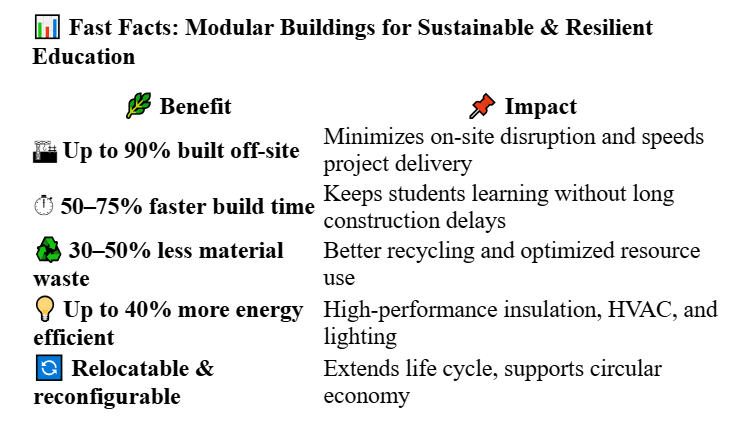Schools and colleges face a complex set of challenges: aging facilities, enrollment fluctuations, budget constraints, and the need to meet ambitious environmental and resiliency goals. Modular school buildings—once considered only temporary fixes—are now emerging as a cornerstone of sustainable construction strategies in education.
A Smarter Way to Build
Modern modular buildings are a far cry from the portable classrooms of decades past. Today’s designs meet or exceed the same building codes as traditional construction, offering permanent, high-performance spaces built off-site in controlled environments. This approach minimizes construction waste, reduces site disruption, and accelerates project timelines—often delivering a new classroom or lab in a fraction of the time required for conventional builds.
Because modules are prefabricated in factories, material usage is more efficient, and leftover materials can be recycled more easily. Transportation to the site is streamlined, and on-site assembly is quicker, meaning reduced traffic and noise for surrounding communities.
Reducing the Carbon Footprint
Sustainability in education facilities is not just about meeting code—it’s about aligning with California’s broader decarbonization goals. Modular construction offers significant carbon benefits:
- Lower embodied carbon due to optimized material use and reduced waste.
- Energy-efficient systems integrated during fabrication, including high-performance HVAC, LED lighting, and advanced insulation.
- Solar-ready rooftops and designs that accommodate renewable energy integration.
- Water-efficient fixtures and the option for rainwater harvesting systems.
Since modular buildings can be relocated, repurposed, or reconfigured, they also support circular economy principles—extending the usable life of materials and reducing the demand for new construction resources.
Resiliency in the Face of Disruption
California schools and colleges increasingly need facilities that can adapt to climate-related challenges, seismic events, and shifts in program needs. Modular buildings excel in this area:
- Seismic and wind resistance: Engineered to meet or exceed local resilience standards.
- Rapid deployment: When a campus suffers damage due to wildfire, flooding, or earthquakes, modular facilities can be in place within weeks, ensuring educational continuity.
- Flexibility: Space can be reconfigured for changing needs, from classrooms to labs, wellness centers, or administrative hubs.
- Durability: Modern materials are designed to withstand heavy use while maintaining indoor environmental quality.
In emergency scenarios, modular units can also serve as temporary shelters or community response centers, supporting broader resiliency efforts.
Cost-Efficiency for Public Sector Budgets
For school districts and colleges, fiscal responsibility is paramount. Modular construction can reduce project costs through faster build times, predictable budgets, and economies of scale in manufacturing. Reduced site labor and fewer weather-related delays help projects stay on schedule and within budget.
Moreover, the long-term operational savings from energy-efficient systems make modular solutions even more attractive. When paired with funding from California’s state and federal facilities programs, modular buildings can deliver high-performance spaces without overburdening local budgets.
Case Studies and Community Impact
Districts across California are turning to modular solutions for both new construction and modernization:
- Urban campuses constrained by space can stack modules for multi-level learning environments.
- Rural colleges use modular buildings to expand workforce training programs quickly in response to community needs.
- Disaster recovery efforts rely on modular classrooms to restore learning environments while permanent structures are rebuilt.
In each case, the community benefits not just from a functional space, but from a facility designed with sustainability and resiliency in mind.


